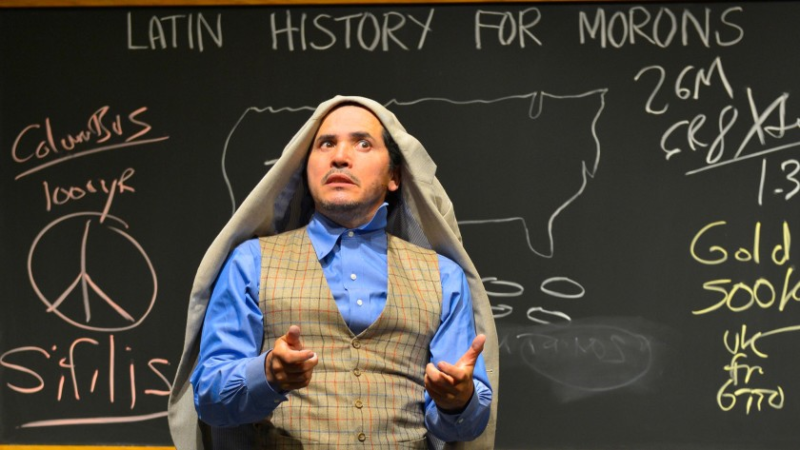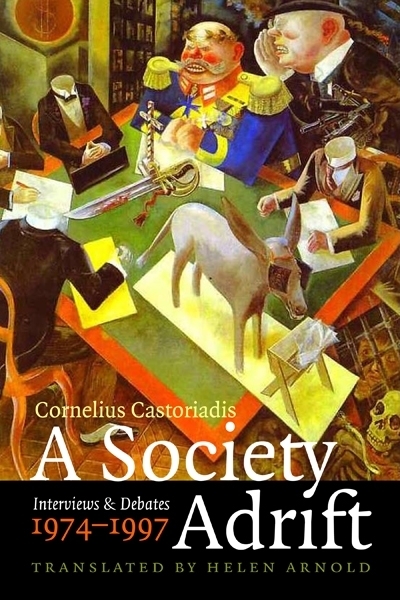The student make-up of my courses is young Latinx, by a wide margin, with a smattering of other students of color mixed in. Because I differ with my students in every major category—age, ethnicity, race, and socio-economic class—I’m always looking for ways to know them, relate to them, and understand their agendas. Because I teach US history, I’m always trying to figure out how to teach that history in a way that makes it relevant and interesting to them.

John Leguizamo in “Latin History for Morons” on Netflix.
This is why I found myself watching the John Leguizamo special on Netflix, “Latin History for Morons.”
If there was chatter about this show, I missed it, so I don’t know how familiar people are with the program. It’s a stand-up act, meant to entertain, and there are many good things to say about it. I wouldn’t steer anyone away from watching it, certainly not my students. It didn’t, however, clarify much about my ongoing problem of relating to my students and making relevant the content I teach them. Rather, it reinforced what is most complicated about that problem.
Leguizamo frames his show as a narrative. His son is in a private New York elementary school. He is sometimes bullied for his ethnicity, his race. His history instruction is no help. Latinos don’t appear in that curriculum, except as victims or villains. When he receives an assignment to report on a hero, his father wants him to choose a Latin American hero. There are no Latin heroes, retorts the son. So Leguizamo undertakes a quest to find his son a Latin hero.
Is history the story of heroes? Maybe it is in elementary school. Maybe it has to be. I remember when my children were younger, and they were confused by or rejected movies I thought they might like. It was the hero, I decided, that made the difference. My kids didn’t like anti-heroes or weak heroes. They wanted the strong, sympathetic, moral model they were used to. This is perfectly reasonable. Things must be simple and straightforward at first. Sophistication comes later. When we teach the young history, I suppose we must have Christopher Columbus the discoverer, George Washington and the cherry tree, Lincoln the emancipator, King the dreamer, and so on.
Start the youngsters off with the feel good stories. Eventually they are old enough not to need them anymore.
So when are students old enough to no longer require heroes? In my class of mostly freshmen, the assumption still seems to be that when we’re talking about a person, we’re talking about someone to admire and emulate, and when we’re talking about an idea or argument, the point is to inspire or encourage. Maybe they have this assumption because it’s what they’re used to. If it’s my job to adjust my students’ impression of what studying history is about, I don’t have a problem with that. I’m not sure John Leguizamo is helping, though. He’s out there on Netflix looking for a hero.
I haven’t always taught Latinx-heavy classes. In other institutions, I had a more mixed demographic of American students, as well as international students from all over the world. Because the latter had come to Texas to study, they had to abide by the state’s requirement to take a couple of US history courses. I doubt very much they were in need of an American hero to emulate or to boost their self-esteem.
What did they require, then, of a US History course? Once, early on in the semester, one of these students, a Chinese national, came up to me after class. She said she’d figured out the theme of my course: “White people are assholes.”
How did I respond? “People in power are assholes.” Something like that. “Human beings are assholes.” I should have had something better prepared. Truth is, the comment caught me off guard, and it stung a little. Was this really the message I was sending? Had I become that right-wing boogieman, the fanatic professor inculcating the youth with a hatred of America?
I decided this was an over-reaction. Rather, the incident was evidence of actual learning taking place, on her part and on mine. If there was a miss-match between what I intended and what was received, well, what of it? When you shift from history as a record of the achievements of heroes—or from history as a process of nation-building, which I suspect is what the Texas legislature intends—to history as a practice of critical thinking, there will be bumps in the road.
In my course, we’re going to think contextually, we’re going to take multiple perspectives into account. We’re going to read carefully and contemplate language and metaphor. We’re going to think about history, yes, but we’re also going to think about the history of history. Does that mean we’ll never make a judgment or occupy a moral position? No. I don’t want to give the impression that I think telling stories with heroes and critical thinking are wholly different practices. Inspiration, encouragement, admiration, and emulation are not off the table completely. But there will be a process of—what, provisional neutrality?—where received knowledge may be put to the test, and a space made for revelation, for change. The Greek political theorist Cornelius Castoriadis calls this “autonomy.”
 For Castoriadis, autonomy is the capacity of an individual or a society to “explicitly call into question, and change through explicit action, the law presiding over its existence.” That law rests largely on stories told, in particular ways, using particular imagery and language. Autonomy is a space where “questions are posed overtly: Are our laws just? Are our gods true? Is our representation of the world right?” (57-58) For Castoriadis, autonomy is the essence of freedom.
For Castoriadis, autonomy is the capacity of an individual or a society to “explicitly call into question, and change through explicit action, the law presiding over its existence.” That law rests largely on stories told, in particular ways, using particular imagery and language. Autonomy is a space where “questions are posed overtly: Are our laws just? Are our gods true? Is our representation of the world right?” (57-58) For Castoriadis, autonomy is the essence of freedom.
When I write, I’m in that autonomous space. In fact, I’m thinking now about how important the link is between history and identity, between identity and status or self-esteem. I’m thinking about how much more or much less personally students may take topics than I take them—about how, for instance, American slavery may be a more painful topic for others than it is for me. I’m thinking about how particular students who have seemed irritated, uninterested, or disengaged, sit up straighter and get a light in their eye when we talk about, say, the Black Panthers, when we look at that photo of them, armed, in formation, on the steps of the capitol building in Sacramento. I’m thinking of how the Panthers and their contemporaries in the Chicano movement called for new curricula, new history courses, and cultural studies programs, and connected these curricula with the awareness of identity, pride, and self-worth. People need heroes. I need heroes. John Leguizamo’s quest makes sense.
I watched “Latin History for Morons” to the end, and I don’t want to spoil it too much. Let’s just say, Leguizamo and I land in the same place, sort of. It turns out, we both have our heroes, and they aren’t the kind who command and conquer and deliver blows, but the kind who seek out autonomy and use it. Let’s just say that my international student was too hasty in her conclusion, that we weren’t even halfway through the course, and that we hadn’t gotten to Douglass, Thoreau, Whitman, the Grimkes, Melville, or Cady Stanton, yet.

0